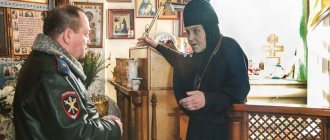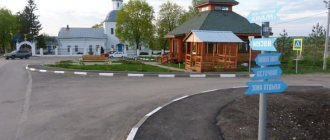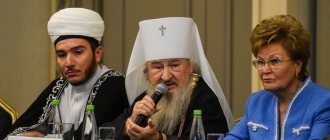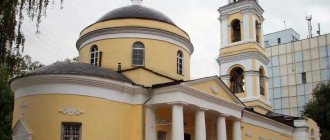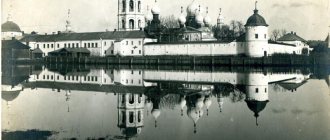Ambiguous information is published about the Bishop of the Russian Orthodox Church Zosima (Ostapenko).
On the official website of the Moscow Patriarchate he is listed as a worthy hierarch with titles and awards.
And the news publication “Caucasian Knot” talks about some excesses and abuses of power.
We will talk about Archbishop Zosima (Ostapenko), now the administrator of the Solikamsk diocese.
Archbishop Zosima Ostapenko, Administrator of the Solikamsk Diocese
Archbishop Zosima Ostapenko was left an orphan at the age of 14 and after the army he studied at a theological seminary
The future hierarch, Vladimir Mikhailovich Ostapenko, was born in Kazakhstan, Tselinograd region, p. Novocherkassk, in a family of employees. Left orphaned at the age of 14, he graduated from boarding school, after which he served 2 years of military service in the Armed Forces of the Soviet Army.
After the army he entered the Moscow Theological Seminary. During his studies, he performed obedience in a church in the Moscow region, Odintsovo district, village. Dmitrovskoe.
After graduating from the seminary, in Makhachkala he served as a psalm-reader in the Church of the Dormition of the Mother of God.
Seven years later, he was ordained a deacon by Archbishop Anthony, and a month later - a priest.
Appointed to serve as a full-time priest at the Church of the Archangel Michael in Grozny.
Three years later he was transferred to the Holy Cross Church, which was the only one in Kalmykia at that time, in the village. Sheltered. A year later he was transferred to Elista and appointed rector of the Holy Cross Church. He was tonsured a monk with the name Zosima, in honor of the Venerable Zosima of Solovetsky
After two years, with the blessing of Archbishop Anthony of Stavropol and Baku, he was tonsured with the name Zosima, elevated to the rank of abbot and appointed dean of all Kalmyk parishes.
As a dean, he opened the first Sunday school in the diocese, built the Kazan Cathedral in Elista, and laid the foundations for the construction of two churches in the diocese. He was elected as a deputy of the Supreme Council of Kalmykia.
Eight years later he was elected to the position of Bishop of Elista and Kalmykia. Patriarch Alexy II of Moscow elevated him to the rank of archimandrite, then to bishop. After eleven years - to the rank of archbishop.
1995
this year Zosima Ostapenko was elevated to the rank of bishop
Five years later, by the decision of the Holy Synod, Vladyka Zosima becomes the manager of the Vladikavkaz and Makhachkala departments. In the same year, Archbishop Zosima of Vladikavkaz was appointed to the position of rector of the Alan Dormition Monastery (village Khidikus, Republic of North Ossetia-Alania).
A year later, Archbishop Zosima was given the title “Vladikavkaz and Alan”, in connection with the newly formed Makhachkala diocese.
Four years later, due to health reasons, he was dismissed and moved to Moscow. Five months later, he was appointed Archbishop of Solikamsk and Chusovsky.
Dates of the life path of Vladika Zosima
| date | Event |
| July 12, 1950 | Birthday |
| 1968 | Finished school |
| 1968-1970 | Military service |
| 1970-1974 | Studying at the Moscow DS |
| December 13, 1981 | Ordained deacon |
| December 27, 1981 | Ordained priest, Grozny |
| 1984 | Appointed to parish in Kalmykia |
| 1985 | Appointed rector of the Holy Cross Church, Elista |
| August 21, 1987 | Took monastic vows |
| October 7, 1995 | Elevated to the rank of archimandrite |
| December 24, 1995 | Consecrated Bishop |
| October 6, 1995 | Appointed bishop of the Elista and Kalmyk diocese |
| February 24, 206 | Elevated to the rank of archbishop |
| March 22, 2011 | Appointed Bishop of Vladikavkaz and Makhachkala |
| June 3, 2016 | Sent to rest |
| October 21, 2016 | Appointed bishop by the Solikamsk diocese |
Excerpt characterizing Zosima (Metropolitan of Moscow)
“We were told to be there at nine o’clock, but we weren’t even halfway through.” These are the orders! - repeated from different sides. And the feeling of energy with which the troops went into action began to turn into annoyance and anger at the stupid orders and at the Germans. The reason for the confusion was that while the Austrian cavalry was moving on the left flank, the higher authorities found that our center was too far from the right flank, and the entire cavalry was ordered to move to the right side. Several thousand cavalry advanced ahead of the infantry, and the infantry had to wait. Ahead there was a clash between the Austrian column leader and the Russian general. The Russian general shouted, demanding that the cavalry be stopped; the Austrian argued that it was not he who was to blame, but the higher authorities. Meanwhile, the troops stood, bored and discouraged. After an hour's delay, the troops finally moved further and began to descend down the mountain. The fog that dispersed on the mountain only spread thicker in the lower areas where the troops descended. Ahead, in the fog, one shot was heard, then another, at first awkwardly at different intervals: draft... tat, and then more and more smoothly and more often, and the matter began over the Goldbach River. Not expecting to meet the enemy below the river and accidentally stumbling upon him in the fog, not hearing a word of inspiration from the highest commanders, with the consciousness spreading throughout the troops that it was too late, and, most importantly, in the thick fog not seeing anything ahead and around them, the Russians lazily and slowly exchanged fire with the enemy, moved forward and stopped again, not receiving orders from the commanders and adjutants, who were wandering through the fog in an unfamiliar area, not finding their units of troops. Thus began the case for the first, second and third columns that went down. The fourth column, with Kutuzov himself, stood on the Pratsen Heights. At the bottom, where the matter began, there was still a thick fog, at the top it had cleared, but nothing was visible from what was happening ahead. Whether all the enemy forces, as we assumed, were ten miles away from us or whether he was here, in this line of fog, no one knew until the ninth hour. It was 9 o'clock in the morning. The fog spread like a continuous sea along the bottom, but near the village of Šlapanice, at the height at which Napoleon stood, surrounded by his marshals, it was completely light. Above him was a clear, blue sky, and a huge ball of the sun, like a huge hollow crimson float, swayed on the surface of a milky sea of fog. Not only all the French troops, but Napoleon himself and his headquarters were located on the wrong side of the streams and the bottoms of the villages of Sokolnitz and Shlapanitz, behind which we intended to take a position and begin business, but on this side, so close to our troops that Napoleon could in our army to distinguish horse from foot. Napoleon stood somewhat ahead of his marshals on a small gray Arabian horse, wearing a blue overcoat, the same one in which he fought the Italian campaign. He silently peered into the hills, which seemed to protrude from a sea of fog, and along which Russian troops were moving in the distance, and listened to the sounds of shooting in the ravine. At that time, his still thin face did not move a single muscle; the shining eyes were motionless fixed on one place. His assumptions turned out to be correct. Some of the Russian troops had already descended into the ravine to the ponds and lakes, and some were clearing those Pratsen heights, which he intended to attack and considered the key to the position. He saw, in the midst of the fog, how, in a depression made up of two mountains near the village of Prats, Russian columns, all moving in one direction towards the hollows, bayonets shining, disappeared one after another into the sea of fog. According to the information he received in the evening, from the sounds of wheels and footsteps heard at night at the outposts, from the disorderly movement of the Russian columns, from all assumptions, he clearly saw that the allies considered him far ahead of them, that the columns moving near Pratzen formed the center of the Russian army, and that the center is already weakened enough to attack it successfully. But he still hadn't started the business. Today was a solemn day for him - the anniversary of his coronation. Before the morning he dozed off for several hours and, healthy, cheerful, fresh, in that happy mood in which everything seems possible and everything succeeds, he mounted a horse and rode out into the field. He stood motionless, looking at the heights visible from behind the fog, and on his cold face there was that special shade of self-confident, well-deserved happiness that happens on the face of a loving and happy boy. The marshals stood behind him and did not dare to distract his attention. He looked first at the Pratsen Heights, then at the sun emerging from the fog. When the sun completely emerged from the fog and splashed with a blinding brilliance across the fields and fog (as if he was just waiting for this to start the job), he took off the glove from his beautiful, white hand, made a sign to the marshals with it and gave the order to start the job. The marshals, accompanied by adjutants, galloped in different directions, and after a few minutes the main forces of the French army quickly moved towards those Pratsen heights, which were increasingly cleared by Russian troops descending to the left into the ravine. At 8 o'clock Kutuzov rode out on horseback to Prats, ahead of the 4th Miloradovich column, the one that was supposed to take the place of the columns of Przhebyshevsky and Langeron, which had already descended. He greeted the people of the front regiment and gave the order to move, indicating that he himself intended to lead this column. Having reached the village of Prats, he stopped. Prince Andrey, among the huge number of people who made up the retinue of the commander-in-chief, stood behind him. Prince Andrei felt excited, irritated and at the same time restrainedly calm, as a person feels when a long-desired moment has arrived. He was firmly convinced that today was the day of his Toulon or his Arcole Bridge. How this would happen, he did not know, but he was firmly convinced that it would happen. The terrain and position of our troops were known to him, as far as they could be known to anyone from our army. His own strategic plan, which, obviously, now there was no need to even think about putting into execution, was forgotten by him. Now, already entering into Weyrother's plan, Prince Andrei pondered the contingencies that could occur and made new considerations, ones that might require his quick thinking and decisiveness.
Archbishop Zosima has medals and orders, and not only church ones
| Father Zosima's Award | Name |
| Order of Friendship of Peoples, Russia | |
| Medal "For the Glory of Ossetia" of the Republic of North Ossetia | |
| Order of the Holy Blessed Prince Daniel of Moscow, II degree, Russian Orthodox Church | |
| Order of St. Sergius of Radonezh, II degree, Russian Orthodox Church | |
| Order of St. Seraphim of Sarov II degree, Russian Orthodox Church | |
| Order of St. Innocent of Moscow II degree, Russian Orthodox Church | |
| Medal "For Merit", Federal Migration Service, Russian Federation |
Notes
- Macarius (Bulgakov). History of the Russian Church: History of the Russian Church during the period of its gradual transition to independence (1448-1589). M., 1996. P. 68.
- [www.odinblago.ru/golubinskiy2/15 E. E. Golubinsky History of the Russian Church. — M.: Type. Lissner and Roman, 1880-1911.T. 2: Period two. Moscow. From the beginning of the Mongols to Metropolitan Macarius inclusive, 1st half of the volume. - 1900. - VII, 919 p. p. 575]
- [www.pravenc.ru/text/182289.html “Orthodox Encyclopedia” T. 19, pp. 185-194 Judaizers]
- [old.stsl.ru/manuscripts/medium.php?col=1&manuscript=740&pagefile=740-0126 740. (995.) Various ranks, quick, beginning. XVII century Turn of sheet 117]
Interview with Bishop Zosima and his sermons
- Interview of Archbishop Zosima of Vladikavkaz and Makhachkala to the Interfax-Religion portal
- Archbishop of Vladikavkaz and Alan Zosima: Orthodoxy in Ossetia has the deepest roots
- Bishop of Elista and Kalmyk ZOSIMA (Ostapenko) (ROC MP): “It is impossible to allow such an active promotion of Catholicism in Russia, which was the case under Pope John Paul II”
- Archbishop of Vladikavkaz and Alan Zosima: Just as the Caucasus cannot exist without Russia, so Russia without the Caucasus is incomplete
- Word from Archbishop Zosima on the desecration of the Buddha statue in Elista
- Sermon by Bishop Zosima on the occasion of the Epiphany
Archbishop Zosima Ostapenko had a conflict with his flock in North Ossetia
After his appointment to the Vladikavkaz and Makhachkala Sees, Archbishop Zosima, as the ruling bishop, pursues his own personnel policy. The actions of the ruler, an uncompromising person and categorical in his statements, led to an open conflict.
The reason for the confrontation was the appointment of the abbot of the Alan Holy Dormition Monastery, Archimandrite Anthony (Danilov), to Dagestan.
The believing parishioners fell in love with Father Anthony and did not want to part with him.
Despite the requests of the people, the archbishop remained adamant. He motivated that Father Anthony’s extensive missionary experience would bring more benefits in the new place, and in the future the archimandrite would be elevated to the rank of bishop.
The mass indignation of believers, fueled by the hot Caucasian temperament, turned into a conflict between the diocese and the government of the republic. The government took the side of the people.
A group of believers who disagreed with the bishop put their dissatisfaction on paper, collected signatures, and sent them to Moscow. The conflict had to be resolved by the Patriarch. As a result, Vladyka Zosima withdrew the order to appoint Archimandrite Anthony.
By leaving a comment, you accept the user agreement
Literature
- Zosima, Metropolitan of Moscow // Encyclopedic Dictionary of Brockhaus and Efron: in 86 volumes (82 volumes and 4 additional). - St. Petersburg, 1890-1907.
- [www.magister.msk.ru/library/history/makary/mak3202.htm#number2 Metropolitan Macarius. History of the Russian Church
Vol. III, section 2, Chapter 2.] - Modern News (1884, No. 266);
- D. Ilovaisky, More about the heresy of the Judaizers (M. 1884).
- Belyakov, L.L. and E.V. On the revision of the eschatological concept in Rus' at the end of the 15th century. - Archive of Russian History, 1, 1992, 7-31.
- Alekseev, A.I. Notes on the revision of the eschatological concept in Rus' at the end of the 15th century. — In: Medieval Orthodoxy: from parish to patriarchy. Ed. N. D. Barabanov and V. V. Kuchma. Vol. 1. Volgograd, 1997, 111-125.
